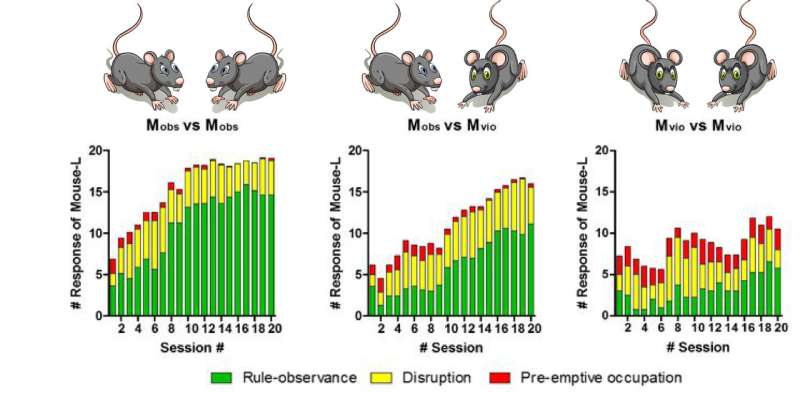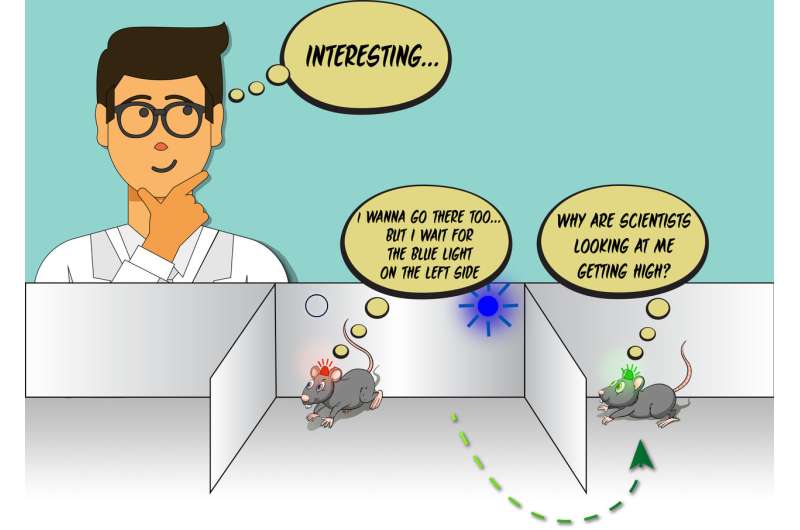(a) Mobs are mice that observe social rules (high rule-observance responses, in green). When both mice cooperate, they quickly learn that if they respect each other, they get more pleasure reward time in total. (b) When one mouse is respectful and the other is not (Mvio, mice violating the social rule), the latter learns the rule after several experiment sessions. (c) When both mice violate the rule, they also have less incentive to start a new session. Pre-emptive occupation (red columns), which is the quick occupation of the other’s mouse section of the box, goes against ‘social rules’ and requires a lot of energy. Interestingly, even the most respectful mice pairs are still tempted to move to the reward zone (disruption as indicated in yellow is still present in all experiments, even at the 20th session), but other experiments showed that Mobs invade the other’s space at the end of the session, not at the beginning (pre-emptive occupation, red). Credit: freepiks
Humans have learned to live together by solving most conflicts with compromises and rules rather than aggression. But how did this evolve in the first place? But do animals learn to set up new social rules? A new study from the Center for Cognition and Sociality shows that laboratory mice establish rules that provide equal long-term rewards, even if this requires a certain degree of tolerance and patience. Published in Nature Communications, this study reveals how animals and humans evaluate costs and benefits in social interactions.
Competition is risky, stressful and costly in terms of both time and energy. First-come, first-served and territory ownership are examples of rules adopted by humans to avoid aggression and increase mutual benefit. Some animal species, like butterflies, damselflies and social spiders follow them, too. For example, when an animal finds itself in an area belonging to someone else, it retreats and looks for another unoccupied place. But do mammals like rodents have the capability of learning these types of rules? Rodents are driven by impulses, especially when hungry, preferring to eat a small amount of food immediately rather than waiting for a larger portion later. Food is a matter of survival, after all. However, what happens to well-fed mice when the reward is an immaterial sense of pleasure instead of food? In that case, can they learn to adopt new social rules?
IBS scientists used a headset that delivers a wireless electrical brain stimulation (WBS) in the reward circuitry of the brain, called the medial forebrain bundle. The mice feel it as a non-addictive (but irresistible) sense of pleasure, that was previously shown to be preferred over mating. The same brain reward pathway makes humans happy when we eat or spend time with good company. The intra-cranial brain stimulation of the medial forebrain bundle is, in fact, used as a treatment method in patients with serious depression.
For the experiment, mice were trained in a specially designed box with a central area (start zone), and left and right spaces (reward zones). Mice learned to initiate the round by entering the start zone. A blue light indicated where a five-second WBS pleasure sensation was randomly allocated to the left or right reward zone.
Mice implement ‘social rules’ for long-term rewards. Mice begin each experimental session from the central area (start zone) and then learn that a blue light on the left or right areas corresponds to a ‘dose of pleasure’, which is delivered via wireless electrical brain stimulation (pleasure dose) via a headset connected to the pleasure area in their brain. The research team observed that mice develop a ‘social rule’ by splitting the territory: one mouse gets the pleasure dose available in the left zone, and the other mouse in the right zone. Among all tested mice 60% (23 out of 38 mice) waited for their turn. Mice that respect this rule had also more rounds during the experiment, and thus more reward time in total. These mice reached a win-win situation that brings long-term rewards for both mice. Credit: modified from ‘A group of mice’ by brgfx and ‘Flat mind map with character’ in Templates, freepik.com
Then, the scientists placed two trained mice in the same box, in a winner-take-all situation. In this case, mice have to learn that each round starts when both enter the start zone together. Then the light is turned on to the left or right. Moreover, the mice needed to learn that only the first mouse entering the correct reward zone received the pleasure sensation. But as soon as the second mouse entered the same space, the pleasure stimulus was cut off.
The research team observed that mice develop a 'social rule' (reward zone allocation) by splitting the territory: One mouse gets the pleasure dose available in the left zone, and the other mouse in the right zone. Among all tested mice, 60 percent (23 out of 38 mice) waited for their turn. Mice that respected this rule also had more rounds during the experiment, and thus more reward time in total. These mice reached a win-win situation that brings long-term rewards for both mice.
"Violating the rule is not a problem in the short term, but it is not sustainable in the long term," says SHIN Hee-Sup, the leading author of the study. "Mice that respect the social rule learn how to play to their mutual advantage."
The temptation to trespass is still there, though: "From time to time, even the most respectful mice, after waiting some seconds—not to disrupt the other mouse during the 'pleasure dose'—try their luck by going to the opponent's territory," he says. "Then they even go to their own side, sometimes, just to see if they get some sort of pleasure reward, perhaps by chance."
"Beyond this, another rule is tolerance. If a mouse violates the rule, the other mouse has the choice of retaliating immediately, or tolerating and continuing to observe the rule. Tit for tat brings a disruption of the system, while tolerance of a partner's mistakes allows the system to continue. As a result, both mice receive a long-term benefit," explains the professor. "This is called Bourgeois strategy in psychology. It limits aggression and is better for the long term."
Mice and consent rules: the experimental set-up. The video shows how the mice were trained to associate the blue light with a reward. The blue light gets turned off right after the mouse enters into the reward zone. Hungry mice are used for the food reward experiment and well-fed mice for WBS. WBS instills a dose of pleasure in a reward pathway of the brain via a headset implanted in the medial forebrain bundle. The video continues by showing the behavior of two trained mice in the same type of box. In the case of the food experiment, the impulse is driven by hunger, but in the WBS case, it is easier to mice to establish social rules. They define and respect their territory: one mouse receives the reward on the left and the other on the right zone of the box. They are also more tolerant to the mistakes of the other mice. Credit: Institute for Basic Science
Food rewards for hungry mice were also tested for comparison. In this case, mice are more impulsive and more aggressive, even after the end of the experiment. Mice generally establish hierarchy, and aggression was observed in 57 percent of the sessions. On the contrary, aggression happened in only 8 percent of the WBS experiment.
Rule observance increased over time during the test, independently from the mice's body weight or learning ability. The scientists also excluded habituation, the preference for one direction over the other, by swapping the mice couples and putting together mice that previously went to the same side of the box. After the initial disorientation, they quickly establish their territory again: One gets the reward on the left, the other on the right. In technical terms, this phenomenon is referred to as "rapid rule transfer," adapting to a new situation while keeping the same social rule valid.
Next, the IBS research team is curious to know if familiarity between the mice affects their rule-observance behavior. Is it different if they are complete strangers, if they are siblings, or if they mated before the experiment? And maybe even more interestingly, are they going to be so tolerant and patient when they are tricked to believe that the light will turn on randomly 50 percent of the times in each territory, but it is actually asymmetric (say, 90 percent on the left and 10 percent on the right)?
The scientist concludes with a reflective note about contemporary issues: "Actually, these results make me ponder human society. Groups like families are stronger when they cooperate for a long-term future vision, rather than relying on conflict. The same holds true for nations, and up to international relations, which seems often jeopardized these days in many parts of the world, including the Korean peninsula."
More information: Il-Hwan Choe et al. Mice in social conflict show rule-observance behavior enhancing long-term benefit, Nature Communications (2017). DOI: 10.1038/s41467-017-01091-5
Journal information: Nature Communications
Provided by Institute for Basic Science

























